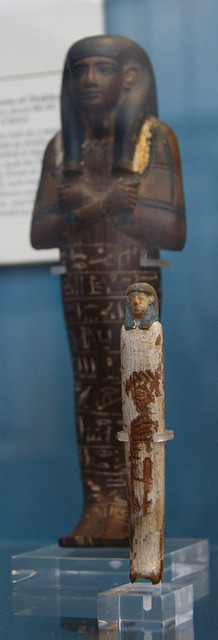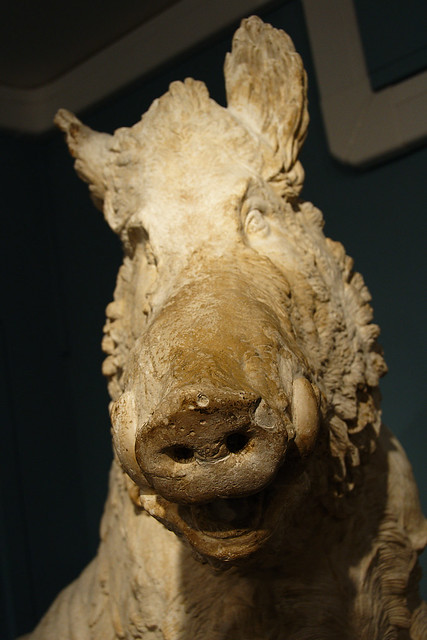Pocahontas only lived for around 22 years, but her short life became an integral part of America’s national mythology. A lot of the things we “all know” about her are wrong, or misleading. Even the name we know her by wasn’t her real name – more of a nickname, meaning “naughty child” or something of that sort. The three experts who discussed what we actually know about her life on In Our Time were Susan Castillo (King’s College London), Tim Lockley (University of Warwick) and Jacqueline Fear-Segal (University of East Anglia).
Pocahontas first appears in the historical record around 1608, when she’s described as a girl of about 10. Although that age is just a guess by a contemporary given the rest of what is said at the time she’s certainly pre-pubescent (not acting nor dressed like an adult woman), and the experts agreed that a birth date of around 1595 seems plausible. She was the daughter of Powhatan, who was the primary leader of the Native American tribes living in the Tidewater area of Virginia. There were several sub-chiefs below him in status, and he was expanding his empire/area of influence. The society she grew up in was matrilineal, but the chief was always a man. So although she was daughter of the chief she wouldn’t convey the right to leadership herself or inherit any power. She was, however, Powhatan’s favourite child.
In 1607 the English made another attempt to establish a colony in North America. This was a government encouraged effort, but the English government weren’t particularly involved in funding any of the colonisation preferring instead to rely on private investors. North America had been pretty much ignored by the Spanish colonial forces because it didn’t have as readily available gold as South America. But the English were beginning to want their own overseas empire (to play with the big boys) and this was available real estate that might be able to be be made profitable. Roanoke, the first colony, had failed and Jamestown (this new effort) also ran into significant trouble. The experts on the programme were pretty scathing about this – they said that too many of the colonists were gentlemen who didn’t know what they were doing. So it wasn’t just the challenge of farming in an unfamiliar land, it was also the challenge of getting people who’d never farmed before to learn and work hard enough and do it quickly enough to feed the colony. The colonists had to be bailed out more than once by the local Native Americans (led by Powhatan) who provided food that got at least some of them through the harsh winters. In 1610 the remaining few colonists (about 60 out of the original 1000) were in the process of leaving to go home to England when 900 new colonists arrived and forced the original colonists to return to Jamestown to carry on.
Pocahontas is first mentioned by John Smith, who is one of the English colonists. In 1608 he has some sort of meeting with Powhatan (which results in help for the colony and relatively good relations between the peoples). In a letter about that event he mentions Pocahontas. And around that time (afterwards?) she and other children of the Native Americans would come to the English colony to play with the children there (hence the descriptions of her that suggest she’s pre-pubescent at the time). She is also the person who comes to bring the gifts of food from Powhatan (as someone who has status but isn’t threatening in any way, conveying the peaceful intentions of Powhatan at that time). Writing much later (in fact after Pocahontas’s death) Smith elaborates his story and this is where the legend of Pocahontas saving the life of an English colonist comes from. His later account says that he was going to be executed by Powhatan, but Pocahontas put herself between him and her father and persuaded Powhatan to let him go free. The experts were clear that this is most likely to be a later fabrication on Smith’s part because Pocahontas is already becoming mythologised. However if it is accurate, then it’s actually most likely that Smith misinterpreted a staged ritual scene as a reality and that possibly this was some sort of adoption ceremony. Nowhere in Smith’s accounts of his meeting(s) with Pocahontas does he suggest any sort of romantic relationship. At the time of their interaction she was still a child around 10-12 and he was 30 years old, so it seems pretty unlikely. This is a much later addition to the myth – to make it “a better story”.
Pocahontas then vanishes from the record again for a few years. On the programme* the experts said that she is thought to’ve married during this time – to a member of a nearby chiefdom mostly under her father’s control. On a visit to her husband’s people (in 1613 says wikipedia, I don’t remember if they said the date on the programme) Pocahontas was tricked into getting on an English boat at which point she was captured and brought back to Jamestown. During her time in captivity she was converted to Christianity. This is important because one of the rationales given by the English for why it was morally good to colonise North America was that they would then convert the natives to Protestant Christianity rather than let the Spanish convert everyone to Catholicism. This was a goal more talked about than done, unlike the Spanish empire there weren’t mass efforts to convert by the English, however Pocahontas was held up as an example of the “good” that could be done here. So that contributed to both her celebrity status when she visited England, and her later mythologisation.
Relations between Powhatan and Jamestown fairly obviously deteriorated into fighting after Pocahontas was captured. However peace was restored but Pocahontas didn’t return to her people, instead she remained in Jamestown where she married an Englishman named John Rolfe in 1614. Rolfe had been shipwrecked in the Bahamas on his way to Virginia, and his wife and child had died there. When he eventually made his way to Jamestown he brought with him a Bahaman strain of tobacco – which was easier to grow, and more to European tastes, than the native Virginian tobacco. So he played a prime role in the future profitability of the colony. In private letters he talks of his love for Pocahontas, but in more public letters he stresses that he is not overcome by lust instead he’s doing this for the good of the colony etc. On the programme they talked about him being a bit of a conflicted man – he was prone to overthinking things. However they agreed that he probably did love Pocahontas, just that in the very racist society of the England of the time (including the colony in Jamestown) it was an almost perverse thing to do to marry a Native American woman. Not just a heathen, but not even white. Bragg notes in his blog post on the Radio 4 blog that there were only three interracial marriages in Virginia in the 17th Century of which this was the first.
Relations between Powhatan and Jamestown definitely improved after this marriage. There’s some indication that Powhatan was trying to bring them into his empire as a sub-chiefdom like the others (and this started back with John Smith in 1608). They talked a bit on the programme about how one of the problems with relations between the two peoples was differing views on landownership – not just who owned it but completely different systems. This blew up again (after Pocahontas death) as the English colony expanded. The Native American view was that the land you were using was your land, but all of the towns they had were only semi-permanent. The normal process was that the tribe would settle somewhere and the women would farm and the men hunt in the surrounding forest – once the farmland was exhausted and needed to be left fallow the whole community would up sticks and move. But the English came along and started clearing forests or settling on land that wasn’t currently in use because they saw it was “empty” and “unowned” but the Native Americans saw it as not currently in use by anyone but that it would be in future. So the English were reducing the amount of land available for everyone, and later in the century began pushing the Native Americans off even the land they were using as relations between the peoples deteriorated further.
In 1616 John Rolfe and Pocahontas visited England. They didn’t talk much about Pocahontas’s personality on the programme (because we don’t know much) but they did stress that she is thought to’ve been a curious and intelligent woman. So this trip to England was in part because of her desire to know more about the world her husband came from. However it was also something of a diplomatic mission – she was treated as a foreign princess by the English, and her brother (who was involved in Powhatan’s administration) and his wife also accompanied them on the trip. So there was some degree of diplomacy going on and some degree of espionage. There’s an anecdote (possibly apocryphal) of her brother bringing a counting stick to count how many of these English there are … but before they even get to London he’s already thrown the stick away as there are too many to count. I think they said that all the people Powhatan ruled over totalled about 15,000 at the time so that’s quite a big difference between the two countries. Pocahontas and her husband were presented to King James at court as a part of their trip – Rolfe himself was too low status for this sort of treatment so it’s definitely her status that’s driving this. It’s interesting to wonder what would’ve happened if she’d lived – this feels like it’s shaping up to be an alliance of sorts between Powhatan and the English. If Pocahontas had lived long enough to mediate diplomatically between the two would it have lasted longer? But then again probably not, too much entrenched entitlement on the part of the English colonists I suspect.
Pocahontas and Rolfe were actually on their way home to Jamestown when Pocahontas fell ill. On March 10th 1617 there’s a record of a meeting between some English officials and Pocahontas where she’s not mentioned as being in ill health. But on the ship from England she becomes ill and the ship returns to Gravesend where she dies and is buried on March 21st. The experts on the programme preferred the theory that she caught something like dysentery – there’s no indication of a long decline so some sort of catastrophic illness seems most plausible. Later theories (particularly from modern descendants of Powhatan’s people) also include the idea that she was poisoned. But there doesn’t seem to be evidence that the English wanted her out of the way, and that seems to be as much a part of the myth as the romantic relationship with John Smith.

